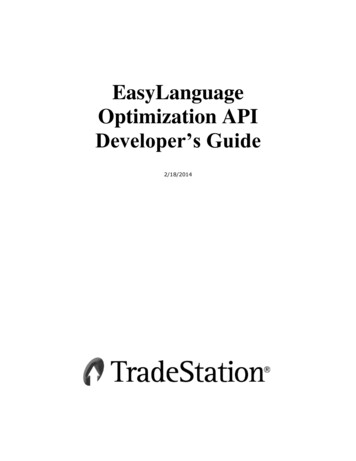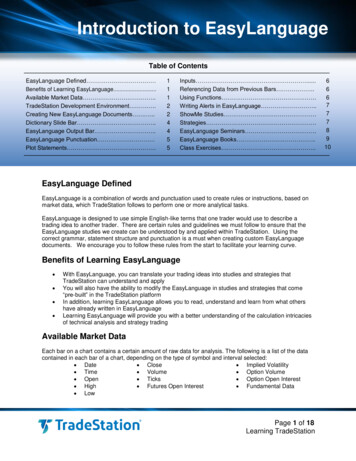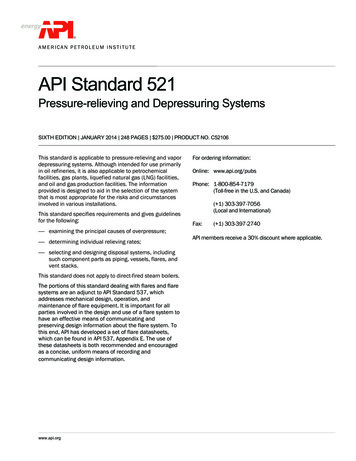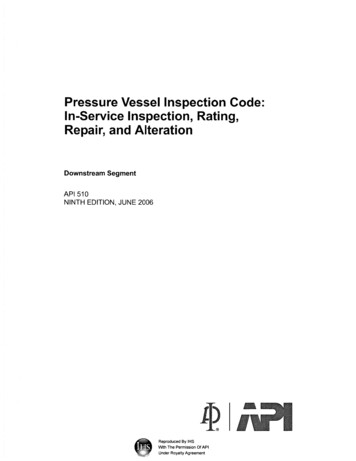
Transcription
EasyLanguageOptimization APIDeveloper’s Guide2/18/2014
IMPORTANT INFORMATION:No offer or solicitation to buy or sell securities, securities derivative, futures products or offexchangeforeign currency (forex) transactions of any kind, or any type of trading or investmentadvice, recommendation or strategy, is made, given or in any manner endorsed by anyTradeStation affiliate and the information made available on this Website is not an offer orsolicitation of any kind in any jurisdiction where any TradeStation affiliate is not authorized todo business, including but not limited to Japan.Past performance, whether actual or indicated by historical tests of strategies, is no guaranteeof future performance or success. There is a possibility that you may sustain a loss equal to orgreater than your entire investment regardless of which asset class you trade (equities, optionsfutures or forex); therefore, you should not invest or risk money that you cannot afford to lose.Options trading is not suitable for all investors. Your account application to trade options will beconsidered and approved or disapproved based on all relevant factors, including your tradingexperience. Please click here to view the document titled Characteristics and Risks ofStandardized Options. Before trading any asset class, customers must read the relevant riskdisclosure statements on our Other Information page. System access and trade placement andexecution may be delayed or fail due to market volatility and volume, quote delays, system andsoftware errors, Internet traffic, outages and other factors.TradeStation Group, Inc. Affiliates: All proprietary technology in TradeStation is owned byTradeStation Technologies, Inc. Equities, equities options, and commodity futures products andservices are offered by TradeStation Securities, Inc. (Member NYSE, FINRA, NFA and SIPC).TradeStation Securities, Inc.’s SIPC coverage is available only for equities and equities optionsaccounts. Forex products and services are offered by TradeStation Forex, a division of IBFX, Inc.(Member NFA).Copyright 2001-2014 TradeStation Group, Inc.
Table of ContentsIntroduction . 1A Simple Optimization App . 1Optimization API Overview . 3The tsopt.Job Class . 4The tsopt.Optimizer Class . 4The tsopt.ProgressInfo Class . 4The tsopt.BestValues Class . 4The tsopt.Results Class . 4The tsopt.OptimizationException Class. 4Defining an Optimization Job . 5Structure of a Job Definition . 5Defining a Job in the Traditional Style . 6Defining a Job with the Tree Style . 8Defining a Job Incrementally . 9Optimizing Strategy Parameters . 11Optimizing by Range . 11Optimizing by List . 11Optimizing Boolean Inputs . 13Setting an Input to a Fixed Value . 13Optimizing a Strategy’s Enabled Status . 13Optimizing Security Parameters . 14Optimizing a Symbol . 14Optimizing an Interval . 15Complex Optimizations over Symbols, Intervals, and Inputs . 16Specifying Job Settings . 17Running an Optimization . 19Define the Optimization Job . 19Define Event Handlers . 19The ProgressChanged Event . 20The JobFailed Event . 20The JobDone Event . 21Start the Optimization . 22Canceling an Optimization . 23Error Handling . 25
Catching Errors in Job Definitions . 25Handling Validation Errors . 25Handling Runtime Errors . 26Summary of Error Handling . 26Retrieving Optimization Results . 27Strategy Metrics and tsopt.MetricID. 27Structure of the Results . 27Retrieving Information about Tests . 28Retrieving Strategy Metrics . 28Using a Named Method for the First Test . 29Using a Named Method for a Specific Test, Trade Type, and Range . 29Using the GetMetric Method . 29Retrieving Optimized Parameter Data . 29Retrieving Specific Kinds of Parameter Data . 30Sorting the Results . 31Example: Writing the Results to a Text File. 32Writing Results the Easy Way . 34Queued Optimizations . 34The Job ID. 35Canceling Queued Optimizations . 37API Reference . 38Job Definition Classes. 38DefinitionObject Class . 38Job Class . 38Securities Class . 39Security Class. 40Interval Class . 43History Class . 46OptSymbol Class . 50OptInterval Class . 51SecurityOptions Class . 54Strategies Class . 55Strategy Class. 56ELInputs Class . 57ELInput Class. 60OptRange Class . 62
OptList Class . 63SignalStates Class . 65IntrabarOrders Class . 66Settings Class . 67GeneticOptions Class . 68ResultOptions Class . 69GeneralOptions Class. 70CostsAndCapital Class. 71PositionOptions Class . 73TradeSize Class . 73BackTesting Class . 74OutSample Class . 76WalkForward Class . 77CommissionBySymbol Class . 78SlippageBySymbol Class . 81AvailableStrategies Helper Class . 83Optimization Classes . 85Optimizer Class. 85JobDoneEventArgs Class. 88JobFailedEventArgs Class . 88ProgressChangedEventArgs Class . 89ProgressInfo Class . 89BestValues Class . 90OptimizationException Class. 92The Results Class . 94Appendix 1: Anatomy of a Tree-Style Definition . 103Appendix 2: Working with the Tree Style . 106
EasyLanguage Optimization APIIntroductionThe EasyLanguage Optimization API gives you all the tools you need to define and run optimizationjobs using EasyLanguage. It gives you control over every aspect of an optimization: Define the security (or securities) to use for the optimization, including the symbol, interval, andhistory range. You can even optimize over multiple symbols or intervals. Define the strategies to use for the optimization. Specify the inputs to optimize. You can now optimize over a list of values or expressions as well asover a range of values. Define the global settings for the optimization, as well as any strategy-specific settings. Monitor the progress of the optimization as it runs. Retrieve and analyze the optimization results when the optimization is done. Handle optimization errors if they occur.Since optimizations are now fully programmable, you can even write an application that executesmultiple optimizations automatically. In fact, you can use the results of one optimization to determinethe parameters of the next optimization; this opens up new possibilities for strategy analysis.The Optimization API also takes full advantage of the multi-threaded optimization engine. This requiresno extra effort on your part. Just specify what you want to optimize and how to respond to events, andthe optimization will automatically use all the cores on your machine. (You can also specify how manythreads to use for the optimization if you wish.)A Simple Optimization AppBefore we delve into the details of the API, here is a simple optimization app written in EasyLanguage.Take a minute to read through the code and get the flavor of the API. The following sections willexplore the techniques used by the application in depth.This TradingApp optimizes the Bollinger Bands LE and SE strategies for the symbol, minute interval,and history range specified in the inputs. The application optimizes the number of deviations for eachstrategy (NumDevsUp and NumDevsDn). The step size to use for the optimization is also specified asan input.The application outputs its progress to the Print Log as it runs, and it outputs the best Net Profit whenthe optimization has completed.If you type in this code yourself, be sure to assign the InitApp method to the TradingApp’sInitialized event.Note that this application will automatically run a multi-threaded optimization if you have multiple coreson your machine.
EasyLanguage Optimization APIusing elsystem;using elsystem.windows.forms;using elsystem.drawing;inputs:Sym("MSFT"),int MinuteInterval(5),LastDate("09/30/2013"),int DaysBack(90),NumDevsStep(0.1);vars:Form form1(null),tsopt.Optimizer optimizer(null);method void InitApp( elsystem.Object sender, elsystem.InitializedEventArgs args )vars:Button startButton;beginform1 Form.Create("OptTest", 500, 500);form1.BackColor Color.LightGray;form1.Dock DockStyle.Right;startButton Button.Create("Start Optimization", 120, 30);startButton.Location(20, 20);startButton.Click orm1.Show();end;method void OnStartButtonClick(elsystem.Object sender, elsystem.EventArgs args)beginStartOptimization();end;method tsopt.Job DefineJob()vars:tsopt.Job job,tsopt.Security security,tsopt.Strategy strategy;beginjob new tsopt.Job;security job.Securities.AddSecurity();security.Symbol l);security.History.LastDateString LastDate;security.History.DaysBack DaysBack;strategy job.Strategies.AddStrategy("Bollinger Bands LE");strategy.ELInputs.OptRange("NumDevsDn", 1, 3, NumDevsStep);strategy job.Strategies.AddStrategy("Bollinger Bands SE");strategy.ELInputs.OptRange("NumDevsUp", 1, 3, NumDevsStep);return job;end;2
EasyLanguage Optimization APImethod void StartOptimization()vars:tsopt.Job job;beginClearPrintLog;Print("Starting optimization.");job DefineJob();optimizer new tsopt.Optimizer;optimizer.JobDone OptDone;optimizer.JobFailed OptError;optimizer.ProgressChanged OptProgress;optimizer.StartJob(job);end;method void OptProgress(Object sender, tsopt.ProgressChangedEventArgs args)beginPrint("Test ", args.Progress.TestNum.ToString(), " of ",args.Progress.TestCount.ToString());Print("", args.BestValues.FitnessName, " hod void OptDone(object sender, tsopt.JobDoneEventArgs args)beginPrint("Optimization done");Print("Net Profit ", args.Results.NetProfit());end;method void OptError(Object sender, tsopt.JobFailedEventArgs args)beginPrint("Optimization Error: ", args.Error.Message);end;Optimization API OverviewAll of the optimization classes reside within the tsopt namespace. Since the namespace identifier isvery short and the classes have simple names that might conflict with other identifiers, importing thenamespace is not recommended. When writing code, it is easy and quick just to type tsopt. and thenselect a class from the pop-up list provided by auto-complete. This also makes it easy to find the classesthat are part of the Optimization API.Throughout the code examples in this guide, we will always include the namespace qualifier with theclass name. This makes it very clear that the class is related to optimizations. We often name thevariable after the class, but without the namespace qualifier. You may find this a useful convention inyour code as well. For example, the following code snippet declares a variable called optimizer as aninstance of the tsopt.Optimizer class:vars:tsopt.Optimizer optimizer(null);3
EasyLanguage Optimization APIHere is a quick overview of the primary classes in the Optimization API.The tsopt.Job ClassThe tsopt.Job class allows a client application to define an optimization job. This definition includesthe securities to be used in the optimization, the strategies to be optimized, and any relevant settings.A job definition always starts with the Job class, but there are also a number of helper classes thatdescribe different parts of the job. For example, a Job object contains a tsopt.Strategies objectthat defines the strategies used in an optimization. The Strategies object is a collection oftsopt.Strategy objects, each of which defines a strategy. A Strategy object in turn has atsopt.ELInputs object which describes the strategy inputs, and so on. The structure of a jobdefinition is described in more detail below.The tsopt.Optimizer ClassThe tsopt.Optimizer class provides methods to start or cancel an optimization job. This is alsowhere you add the event handlers for the optimization.The tsopt.ProgressInfo ClassThe tsopt.ProgressInfo class provides information about the progress of an optimization, suchas the current test number, the time elapsed and remaining, and for genetic optimizations, the currentgeneration and individual. You can retrieve a ProgressInfo object from theProgressChangedEventArgs argument of the ProgressChanged event handler.The tsopt.BestValues ClassThe tsopt.BestValues class provides information about the best fitness result seen so far during anoptimization, along with the optimized parameters associated with that result. Like ProgressInfo,this object can be retrieved from the ProgressChangedEventArgs argument of theProgressChanged event handler.The tsopt.Results ClassThe tsopt.Results class holds the results of an optimization. It can be retrieved from theJobDoneEventArgs argument of the JobDone event handler. The Results class providesmethods to retrieve the strategy metrics for each optimization test in the results set.The tsopt.OptimizationException ClassThe tsopt.OptimizationException class is an exception that can be thrown during theconstruction of a job definition. You can catch this exception in order to debug certain kinds of codingerrors in the definition process (e.g., indexing into an empty Strategies object). The OptimizationAPI also validates a job definition at the start of an optimization to ensure that it is complete and correct.If there are any validation errors, the library will throw a tsopt.OptimizationException.4
EasyLanguage Optimization APINote that the Optimization API does not throw exceptions while an optimization is running. Instead, theerror is reported by calling your JobFailed event handler. An optimization executes asynchronously,so this technique works better for reporting errors that occur during an optimization.Error handling is discussed in more detail below.Defining an Optimization JobThis section provides an overview of the job definition API. For detailed information about each of thejob definition classes, see the API Reference later in this document.Structure of a Job DefinitionA job definition is a tree with three main nodes: Securities, Strategies, and Settings.The Securities node must contain one or more Security nodes that define the securities to use in anoptimization. Each Security node corresponds to a different data series (i.e., Data1, Data2, Data3, etc. inTradeStation). Many optimizations will use only one Security.The Strategies node must contain one or more Strategy nodes that define the strategies to use in anoptimization. The inputs and settings for a specific strategy are specified within its Strategy node.The Settings node can contain one or more nodes that define various global settings for theoptimization. It is permissible for the Settings node to be empty, in which case the default settings areused.A job definition may also specify the OptimizationMethod to use (which can be either Exhaustive orGenetic). If the optimization method is not specified, it defaults to Exhaustive.Every Security node must contain information about the symbol, interval, and history range for thesecurity. If any of this information is missing, the optimizer will throw an exception when you start thejob.A Strategy node requires only the strategy name. If no other information is provided, the default inputsand settings for the strategy will be used. However, most job definitions will provide additionalinformation about a strategy.A job definition can specify that certain parameters within a Strategy or Security should be optimized.For example, a common case is to optimize one or more inputs in a strategy. In the Optimization API,this would normally be specified by calling the OptRange or OptList method for the relevant input.It is possible to optimize some parts of a security as well. For example, you can optimize over a list ofsymbols with the OptSymbol property, or you can optimize over a list of intervals with theOptInterval property.To create a job definition, you must start by creating a tsopt.Job object:5
EasyLanguage Optimization APImethod tsopt.Job DefineJob()vars:tsopt.Job job;beginjob new tsopt.Job;// Define the job herereturn job;end;After creating the job, you can call properties and methods on the Job object to define the differentparts of the job. The following sections describe two different approaches for specifying a job:(1) defining a job in the traditional style; or (2) defining a job with the “tree style.” You can use either orboth of these approaches within a single application.Note that a job definition is essentially declarative. It consists of a series of property and method callsthat declare the contents of a job, but the job definition does not actually do anything on its own. Onceyou define a job, you must pass the definition to the tsopt.Optimizer.StartJob method inorder to execute the job.Since the job definition is declarative, it can easily be translated to and from XML, which is anotherdeclarative format.Defining a Job in the Traditional StyleYou can build up a job definition using a traditional style of coding where each statement either createsan object, sets a property on the object, or calls a method on the object.When you use this style, you will need to define some local variables to hold the various sub-objects thatyou create. (It’s possible to write code in the traditional style without local variables, but it results incode that is very repetitive and hard to read.)At a minimum, you should define local variables for the tsopt.Security and tsopt.Strategyobjects, since you will always need to add at least one security and strategy to the definition:vars:tsopt.Security security,tsopt.Strategy strategy;To add a security to the definition, get the Securities object from the job and call itsAddSecurity method, assigning the result to your local variable:security job.Securities.AddSecurity();You can then define the symbol, interval, and history range for the security.To add a strategy to the definition, get the Strategies object from the job and call itsAddStrategy method, assigning the result to your local variable:strategy job.Strategies.AddStrategy("Bollinger Bands LE");You can then define the information for the strategy, such as the inputs to optimize.6
EasyLanguage Optimization APIYou can repeat this pattern for each strategy you wish to add to the definition. It’s fine to reuse the samelocal variable for each strategy you add.If you want to add settings to your job definition, you may wish to define a local variable for each groupof settings. This is not required, but it makes the code less repetitive. For example, if you want to changeseveral genetic options, you can create a local variable for the GeneticOptions object:vars:tsopt.GeneticOptions geneticOptions;Then you can assign the GeneticOptions object from the job definition to this variable, so that youcan use the variable to set the properties:geneticOptions ionSize 200;geneticOptions.Generations 75;geneticOptions.CrossoverRate 0.8;geneticOptions.MutationRate 0.06;The following example shows a method that defines an optimization job in the traditional style:method tsopt.Job DefineJob()vars:tsopt.Job job,tsopt.Security security,tso
describe different parts of the job. For example, a Job object contains a tsopt.Strategies object that defines the strategies used in an optimization. The Strategies object is a collection of tsopt.Strategy objects, each of which defines a strategy. A Strategy object in turn has a tsopt.ELInputs object which describes the strategy inputs, and .










